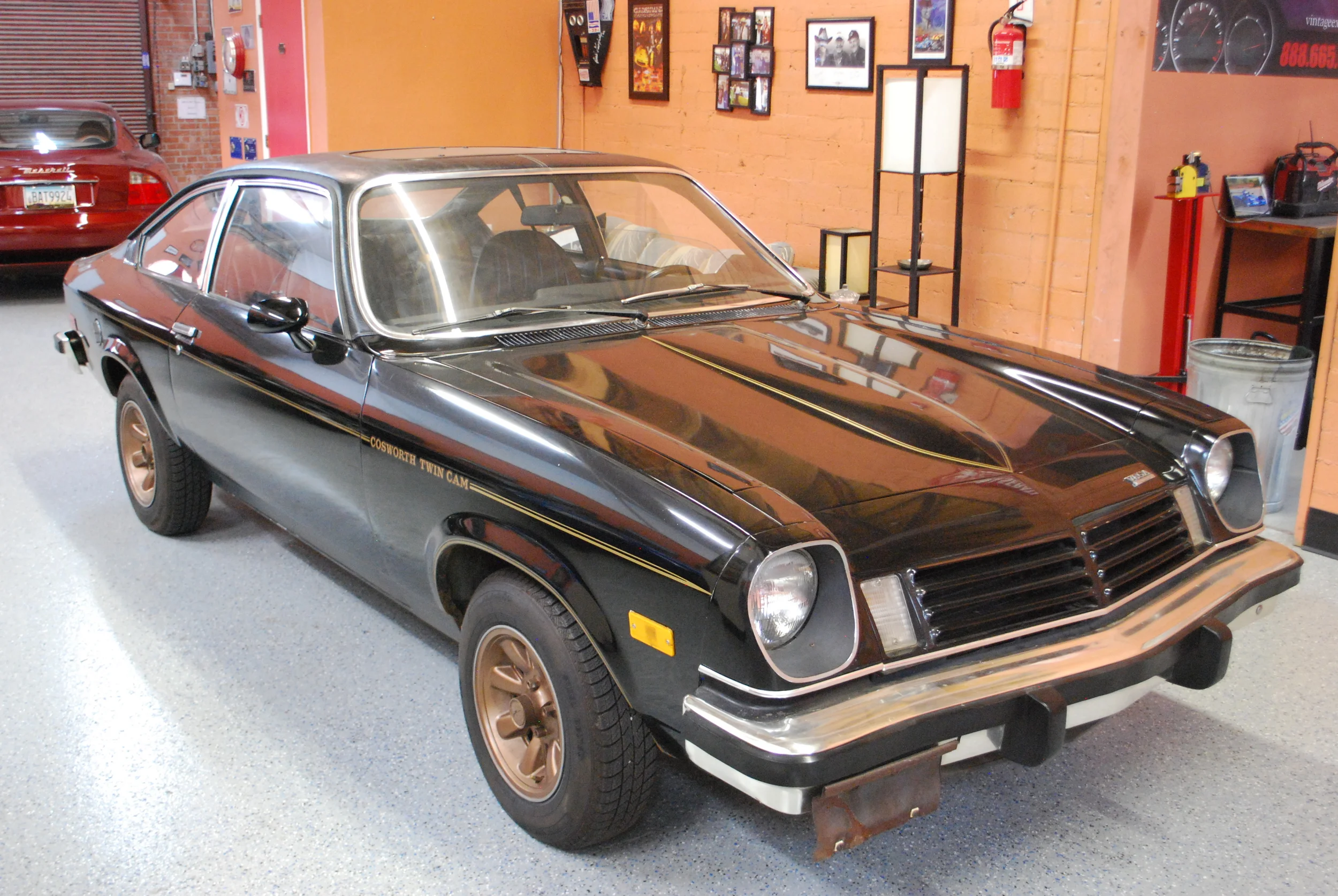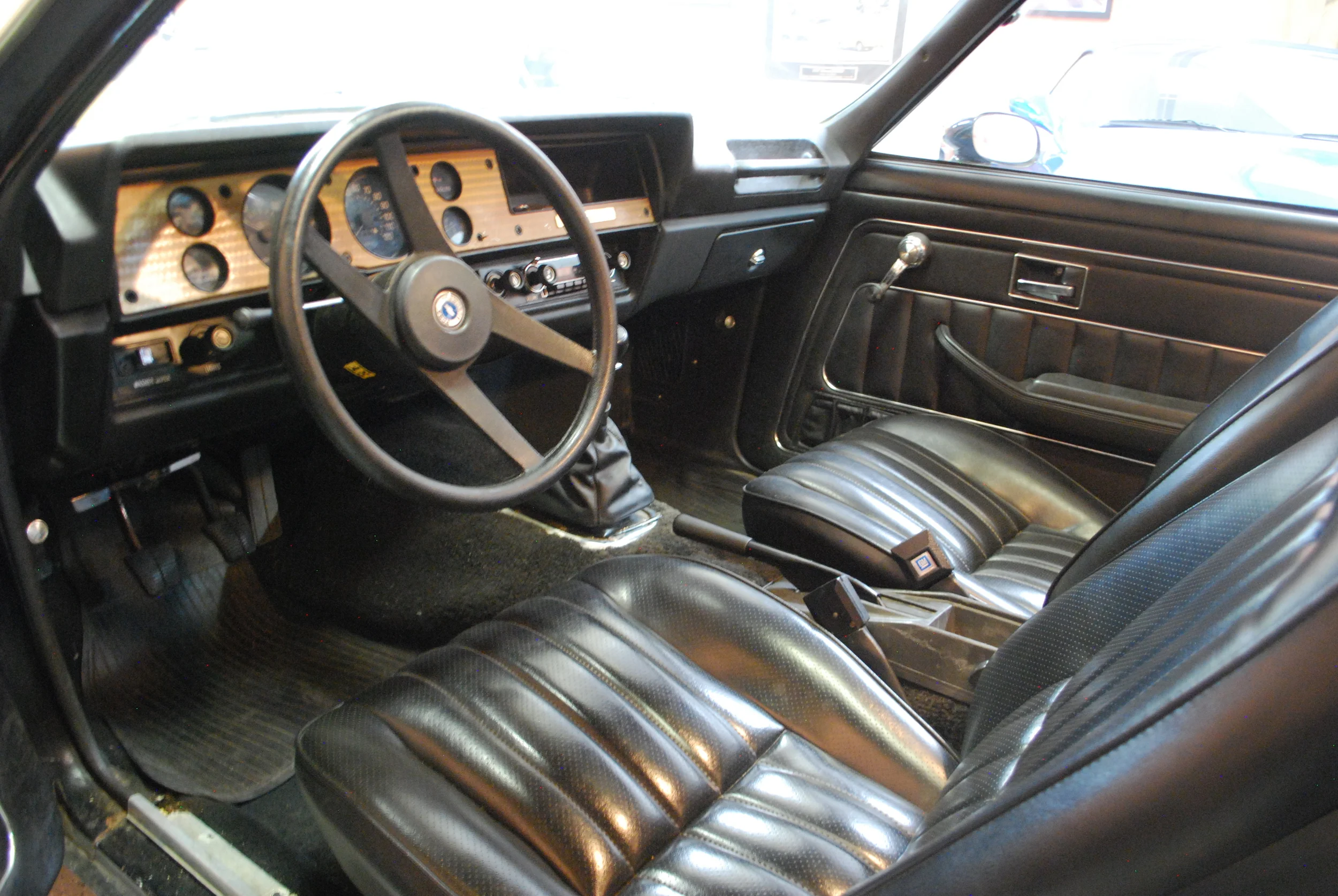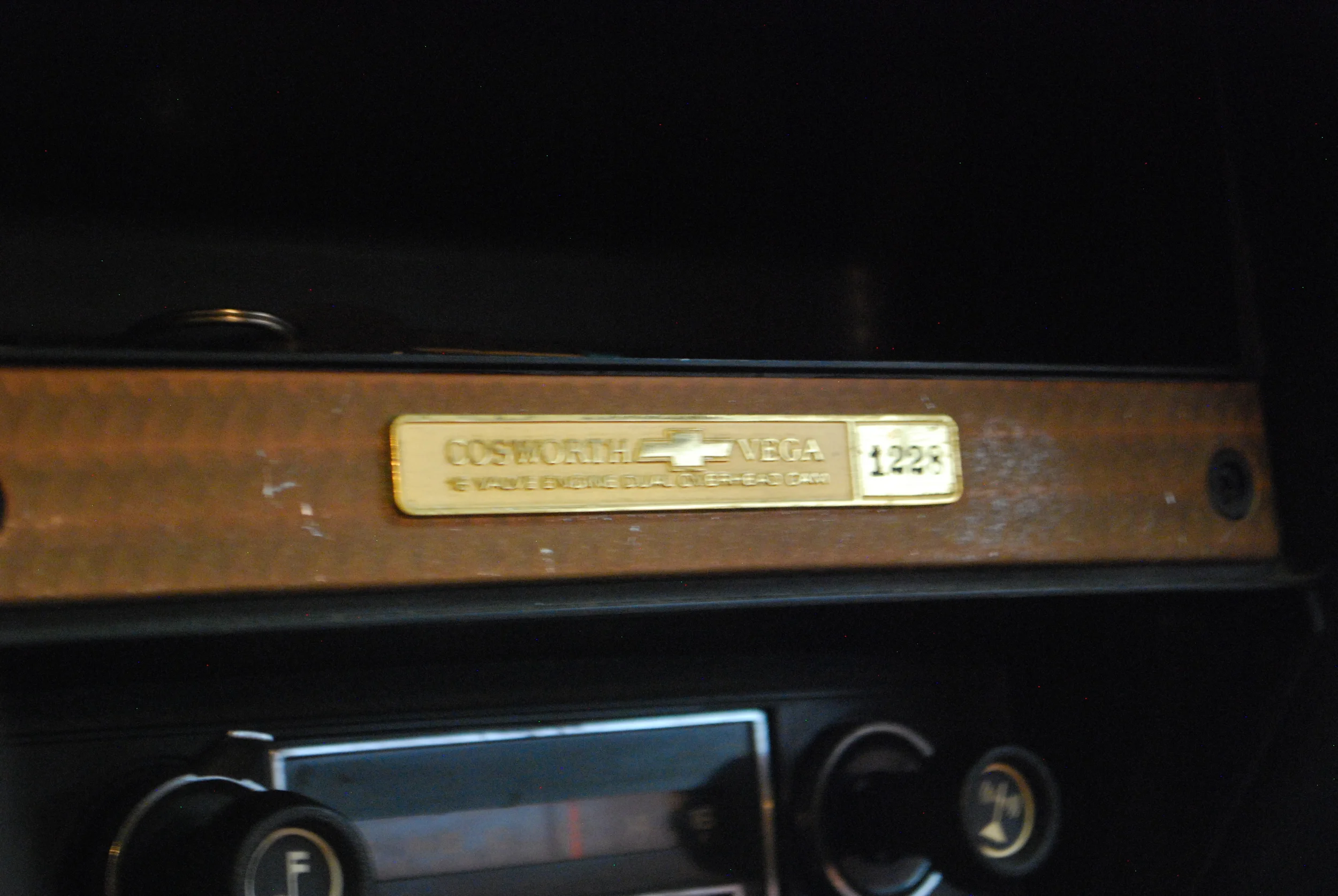We are proud to offer for sale this 1975 Cosworth Vega. This car is one of 2,061 built and is number 1,228 with just 21,290 miles on the odometer. This is a one owner from new car acquired from an estate collection and is being sympathetically refurbished to preserve its original patina and character. The engine runs beautifully and has the original fuel injection on it. the car runs and drives as new and the interior is in excellent condition. Contact us for price and details.


















Origins
In March, 1970 John DeLorean, GM’s general manager and vice-president, sent engine designer Calvin Wade to England in search of cylinder head technology to improve the Vega's performance. Fuel injection would be needed to control emissions without power loss; also stronger internal parts to work with the existing block and the Cosworth head. That summer, DeLorean authorized Wade to build a prototype Cosworth Vega engine. A meager budget, and resistance from managers between Wade and DeLorean, meant low priority for the project, but once approved by DeLorean it could not be killed.
In June, 1971 the prototype gave 170 hp (130 kW) on dual Holley-Weber two-barrel carburetors. At Easter, 1972 GM President Edward Cole drove three Vegas for comparison: a base model, an all-aluminum small-block V8-powered prototype, and the Cosworth. He pledged approval from the Engineering Policy Group for DeLorean's request to initiate Cosworth production. Approval of development aimed at U.S. Environmental Protection Agency (EPA) certification soon followed, and Wade began a 12-car development program to accumulate test mileage in a range of environments including high altitude, heat and cold, to test the engine’s eligibility. At the GM desert proving ground, the car reached 122 mph (196 km/h).
In April, 1973 the design was frozen and two cars were built to accumulate mileage for EPA emission certification. The press was notified of the program and in August 1973 a Car and Driverfeature alerted the public to an upcoming 140 hp (100 kW) Cosworth Vega. The engine needed more dynamometer time, new cam profiles to trade some high-end power for more low-end torque, and a tubular header to replace the cast iron exhaust manifold. Although delayed, the project now received higher priority, more engineering manpower and more funding. Chevrolet dealers began accepting large deposits for early delivery.
The design was frozen again in January, 1974. A stainless steel header was specified, to increase power between 2,000 rpm up and the 7,000 rpm redline. Camshaft lift and duration were eased back and the torque curve reshaped to a street-oriented peak of 5,200 rpm. Project coordinator William Large built two cars for durability testing. By April 1974, the engines ran “clean” for 40,000 miles (64,000 km), after which hydrocarbon curves on the first car rose far in excess of the permitted 3 grams per mile (1.9 g/km), owing to burned exhaust valves. For certification, five months’ durability miles would have to be reaccumulated.
Development resumed, to improve emissions durability and ready the engine for more stringent 1975 standards. The fuel injection was redesigned for better air distribution. High-energy electronic ignition and mandatory catalytic converter were added; also a Pulse Air system, functionally the same as an air pump but without the pump's six-horsepower loss. A larger catalytic converter further guarded against power loss. More advanced ignition timing, and the lead-free fuel required with the converter, prevented exhaust-valve failure.
Chevrolet require all engines to survive 200 hours at full load. The Cosworth lasted over 500 hours. For a clutch burst test, Cale Wade revved the engine to 9,400 rpm under its own power without damage to clutch or engine. Three cars, in three different configurations, resumed mileage accumulation in September 1974.
By January, 1975 the mileage was completed with no failures. One configuration stayed within 1975 California limits, making the Cosworth Vega the only GM car certified for all 50 states. On March 14, 1975 the EPA emissions certificate was issued, allowing sale of 1975 models. Production began immediately to fill the order backlog. 30 engines per day were hand-built — two- and three-worker teams to each engine — in the Tonawanda, New York engine plant's "clean room", originally devised for the ZL-1 all-aluminum 427 cu in (6,997 cc) V8. At the Vega's Lordstown assembly plant, Cosworth production was 1.6 cars per hour. Cosworth Vega 0001, the original Chicago Auto Show vehicle, with a clear Plexiglas hood, is in the GM Heritage Collection.
Production Cars
1975 Cosworth Vega
All 2,061 1975 Cosworth Vegas were finished in black acrylic lacquer with gold "Cosworth Twin Cam" lettering on the front fenders and rear cove panel and gold pinstriping on hood bulge, body sides, wheel openings, and rear cove. (Black was unavailable on other Vegas until mid-1976.) Most have black interiors. The custom interior with perforated vinyl seat trim (RPO ZJ1) was standard, with black cloth seat inserts a $50 option. About 16 percent had white vinyl interiors. All Cosworths had a gold-colored engine-turned dash bezel, gold-plated dash plaque with build sequence number, 8,000 rpm tachometer, and Cosworth Twin-Cam Vega steering wheel emblem.
'Torque arm' rear suspension is like that of the Monza 2+2, and the axle, from the Monza 2+2, gives a 3.73:1 ratio from a 7.5-inch (190 mm) ring gear. A limited slip differential was optional. Included were GT springs, shocks, and stabilizer bars (larger at the rear than the Vega GT's); exclusive BR70-13 BSW radial tires on British-made 6 inch, gold-painted cast aluminum wheels with Chevy center caps; black-finished wiper arms, H.D. radiator and provisions for “Fast Steer” option. The Cosworth was the first Chevrolet passenger car with electronic fuel injection. Air conditioning, power steering and power brakes were not offered. A pilot line 1976 model was built in September 1975, and volume 1976 production began in December 1975.
A 1976 facelift included wider grill, tri-color tail lamps and extensive body anti-rust improvements. A new Borg-Warner five-speed manual overdrive transmission with 4.10 axle was optional. The exhaust system had a single tailpipe instead of 1975’s dual outlets. Seat trim changed to grained vinyl, and the optional extra-charge cloth trim seat inserts were changed to a "houndstooth" type named sport-cloth. In January, a "Sky-Roof" with tinted reflectorized sliding glass and 8-track tape player options were introduced. In February, eight 1976 Vega exterior colors were added: Antique White, Dark Blue Metallic, Firethorn Metallic, Mahogany Metallic, Dark Green Metallic, Buckskin, Medium Saddle Metallic, and Medium Orange; plus two additional interior colors, Firethorn and Buckskin. 1,447 1976 models were built. In November 1975, it had been decided to discontinue the car after the 1976 model year. Total production of 3,508 cars ended in July 1976 with a Medium Saddle Metallic model delivered to a Cleveland, Ohio dealer. 190,321 Vega hatchback coupes were produced in the same period.
Engine
Cosworth Twin-Cam 16-valve
122 cu in (2.0 L) EFI I-4, 110 hp
The Cosworth Vega Twin-Cam engine is a 122 cu in (1,999 cc) inline-four with die-cast aluminum alloy cylinder block and Type 356 aluminum alloy, 16-valve cylinder head with double overhead camshafts (DOHC) held in a removable cam-carrier that doubles as a guide for the valve lifters. Each camshaft has five bearings and is turned by individual cam gears on the front end. The camshafts, water pump and fan are driven by a fiberglass cord-reinforced neoprene rubber belt, much like the Vega 140 cu in (2,294 cc) engine. The cylinder head has sintered iron valve seats and iron cast valve seats. Race-bred forged aluminum pistons with heat-treated forged steel crankshaft and connecting rods enhance durability.
The engine has a stainless steel exhaust header and Bendix electronic fuel injection (EFI), with four injector valves, an electronic control unit (ECU), five independent sensors and two fuel pumps. Some 60 lb (27 kg) lighter than the SOHC Vega engine, it develops maximum power at 5,600 rpm and is redlined at 6,500 rpm, whereas the SOHC Vega engine peaks at 4,400 rpm and runs to 5,000 rpm. Final ratings are 110 hp (82 kW) at 5,600 rpm, 107 lb·ft (145 N·m) of torque at 4,800 rpm. 3,508 of the 5,000 engines were used. GM disassembled about 500 and scrapped the remainder.

